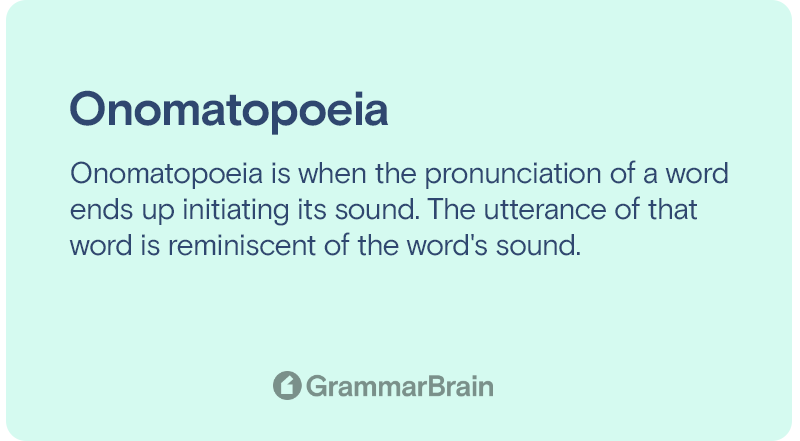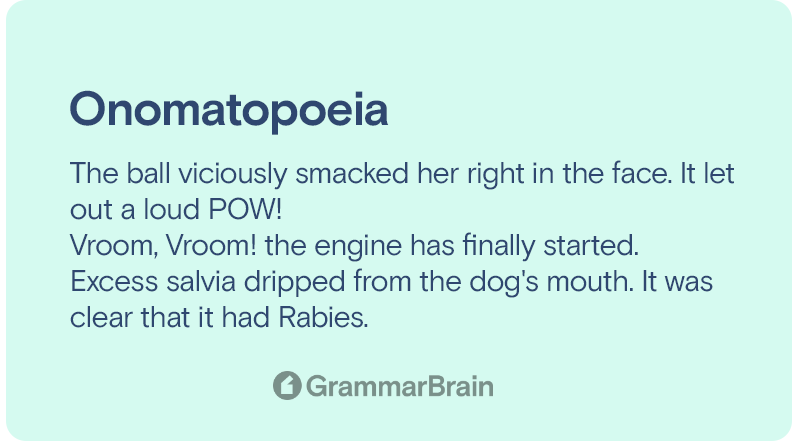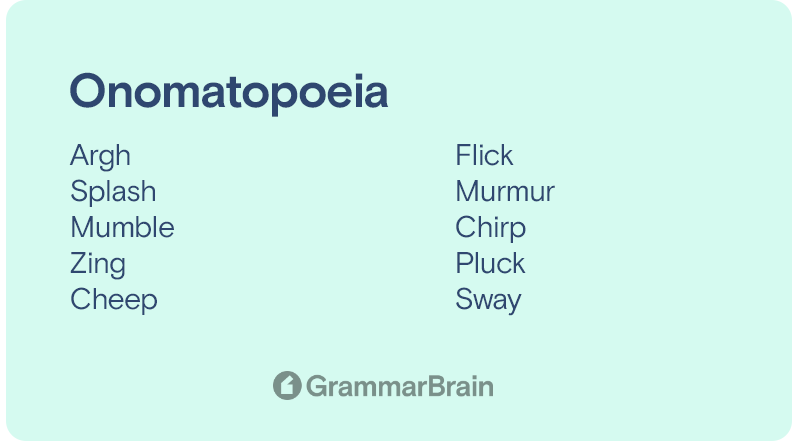What is onomatopoeia? Does the word ‘Onomatopoeia’ sound familiar to you? No? Well, that’s okay because half the global population is foreign to this word.
Most people unintentionally know the meaning of this word. However, they don’t know the term for it, which is ‘Onomatopoeia.’
Today, we will be breaking down this word for you, accompanied by some examples. Let’s dive into it:

What Is Onomatopoeia?
Onomatopoeia is when the pronunciation of a word ends up initiating its sound. The utterance of that word is reminiscent of the word’s sound.
Most poets use Onomatopoeia for accessing the auditory sense of the reader, creating rich and beautiful soundscapes. This poetic device successfully deals with poetry and its wholesome sounds.
However, there are times when people tend to confuse interjections with Onomatopoeia. But both of these words possess different concepts and are polar opposites of each other.
Interjections consist of one of the 8 parts of speech. It’s used to describe a sudden outburst of excitement or emotion of an individual, such as ‘Wow’ and ‘Ouch.’
But certain Onomatopoeic words can be used as interjections, However, the majority of the interjections don’t imitate sounds.
Important Note
There are moments when you will come across words like ‘Ugh,’ ‘Wow,’ and ‘Eek.’ Avoid getting confused here because these words don’t represent Onomatopoeic sounds.
These words express a sudden outburst of emotions instead of a specific sound. Here, you identify these words as exclamations and interjections.
Onomatopoeia vs. Phanopoeia
Phanopoeia consists of a literary device where the general sensation of a certain thing tends to be emulated. Here, the sounds of words that the author uses are emulated.
Let us better demonstrate this with an iconic poem by Franz Wright. Look out for the bold words to identify Phanopoeia.
Heaven, I lived as a monster, my only hope is to die like a child.
In the otherwise vacant and seemingly ceilingless
vastness of a snowlit Boston
church, a voice said: I can do that–if you ask me, I will do it for you.
Did you notice the spaciousness present in the stanza breaks of the poem and the repetitive ‘S’ sounds? They resemble the echoing sounds in an empty church.
Here, the reader gets to experience the church’s vastness via stanza breaks and alliteration. The spacious and sonic quality of the poem enables the readers to delve into the narration and never leave.
Examples of Onomatopoeia
Some onomatopoeic examples consist of words like pitter-patter, boing, zap, gargle, and clap. When you use words in context, you can easily hear their description.
They include:
- The boing sound of spring.
- Chalkboard erasers and their claps.
- The pitter-patter sounds that sound like tiny footsteps when rain falls on the pavement.
Onomatopoeic words end up enhancing a poem or story’s imagery in writing. To be technical, Onomatopoeia isn’t a form of auditory imagery.
It’s because auditory imagery refers to the usage of figurative language, such as metaphors and similes, for describing sounds. But onomatopoeic words can definitely complement the auditory imagery since both devices elevate the work’s sonic qualities.
All onomatopoeic words aren’t mentioned in the dictionary. Most authors choose to come up with their own unique sounds to complement their writing.
You can identify the onomatopoeic words in bold.

Examples in Literature
Let us look at the wordplay of Onomatopoeia in literary examples:
- The bacon sizzled to perfection on the frying pan.
- My phone buzzed as soon as I thought of her.
- I woke up to the pleasant chirping sounds of lovebirds.
- The water splashed all over us as he dived into the pool.
- Asiatic Lions growls like a sinister beast straight up from a movie.
- He slammed the brakes, and the tires screeched. It was a close call.
- The blast let out a loud Boom!
- Thank God! I clicked my mouse at the right time. This Black Friday discount is unreal.
- ‘Ugh,’ I don’t want to work in this environment anymore.
- The leaves rustled as the snake made its way toward the creek.
- Ding, Dong, and the doorbell rang as she was still busy cooking. Alas! the guests have arrived too soon.
- The ball viciously smacked her right in the face. It let out a loud POW!
- Vroom, Vroom! the engine has finally started.
- Excess salvia dripped from the dog’s mouth. It was clear that it had Rabies.
- The snake hissed viciously as I caught its sight.
Examples in Movies
Onomatopoeic words are very much present in movies as well. Here are some of our favorites, which you will also love:
- “And like that, Poof, he is gone.” – This line comes from “The Usual Suspects.’
- “Pity about poor Catherine, though. Tick-tock, Tick-tock.” – This sinister line was said by Hannibal Lector from the suspense-filled thriller film ‘Silence of the Lambs.”
- “Ding-dong the witch is dead!” – Who doesn’t remember this hilarious script from ‘The Wizard of Oz’?
- “Pow!” The Joker, making an explosion sound before blowing up a hospital.” – Yes! it comes from “The Dark Knight.”
Examples in Poems
Now, let us look at how Onomatopoeic words are widely available in the poetry universe.
The Highwayman – Alfred Noyes
“Over the cobbles, he clattered and clashed in the dark inn-yard,
He tapped with his whip on the shutters, but all was locked and barred.”
The Bells – Edgar Allan Poe
How they clang, and clash, and roar!
What a horror they outpour
On the bosom of the palpitating air!
Yet the ear it fully knows,
By the twanging
And the clanging
The Tempest, Act 3, Scene 2 – William Shakespeare
“Sometimes a thousand twanging instruments
Will hum about mine ears, and sometimes voices.”
Morte D’Arthur – Alfred Lord Tennyson
“And answer made the bold Sir Bedivere:
“I heard the ripple washing in the reeds,
And the wild water lapping on the crag.”
Henry V, Act 3, Scene 1 – William Shakespeare
“But when the blast of wars blows in our ears”
Honkey Tonk in Cleveland – Carl Sandburg
“It’s a jazz affair, drum crashes and cornet razzes.
The trombone pony neighs, and the tuba jackass snorts.”
The Pied Piper of Hamelin – Robert Browning
“There was a rustling that seemed like a bustling
Of merry crowds justling at pitching and hustling,
Small feet were pattering, wooden shoes clattering,
Little hands clapping and little tongues chattering,
And, like fowls in a farmyard when barley is scattering.”

Onomatopoeia Words List
We are curating a list of Onomatopoeic words that will help you get a better hold of their usage. Plus, it will also widen your Onomatopoeic dictionary, allowing for easier wordplay in your writings.
- Argh
- Splash
- Mumble
- Zing
- Cheep
- Squeak
- Spit
- Fizz
- Munch
- Swish
- Achoo
- Zap
- Snort
- Flick
- Murmur
- Chirp
- Pluck
- Sway
- Ahem
- Squawk
- Mutter
- Chomp
- Shuffle
- Splat
- Yikes
- Flip
- Screech
- Neigh
- Bang
- Squelch
- Choo-choo
- Oink
- Swoosh
- Snore
- Shush
- Splatter
- Plop
- Squish
- Bash
- Flip-flop
- Splish
- Chortle
- Ouch
- Flop
- Bam
- Ooze
- Splosh
- Sizzle
- Slish
- Flutter
- Clang
- Poof
- Phew
- Slither
- Bark
- Giggle
- Snip
- Ping
- Slap
- Clash
- Slosh
- Bawl
- Ping Pong
- Glug
- Slash
- Slurp
- Pong
- Rustle
- Clank
- Pitter Patter
- Beep
- Groan
- Zip
- Clap
- Yelp
- Plink
- Belch
- Clack
- Growl
- Blab
- Clatter
- Grunt
- Blare
- Smack
- Click
- Blurt
- Guffaw
- Clink
- Snap
- Boing
- Gurgle
- Clip Clop
- Hack
- Boink
- Snarl
- Haha
- Sniff
- Cluck
- Bonk
- Hiccup
- Clunk
- Bong
- Hiss
- Cock a doodle doo
- Hohoho
- Boo
- Cough
- Howl
- Honk
- Boo-hoo
- Pop
- Crack
- Hoot
- Hoot
- Boom
- Pow
- Howl
- Crackle
- Bow-wow
- Purr
- Huh
- Thwack
- Vroom
- Twang
- Crash
- Quack
- Hum
- Brring
- Rattle
- Creak
- Ribbit
- Jangle
- Bubble
- Whirr
- Whoop
- Thud
- Jingle
- Tic-toc
- Croak
- Ring
- Tweet
- Bump
- Ker-Ching
- Crunch
- Whip
- Whish
- Burp
- Kerplunk
- Waffle
- Cuckoo
- Tinkle
- Knock
- Thump
- Buzz
- Ugh
- La
- Whisper
- Ding
- Trickle
- Whack
- Lub Dub
- Rip
- Cackle
- Whoosh
- Ding Dong
- Whizz
- Whallop
- Meow
- Roar
- Chatter
- Wham
- Zoom
- Whoop
- Moan
- Rumble
- Whimper
- Drip
- Moo
- Rush
How to Use Onomatopoeia
Onomatopoeia can be incorporated into different writing styles, but one shouldn’t abuse its usage. Are you interested in using it for a nonfiction book? a short book? or are you writing a novel?
Regardless, we will be guiding you throughout the process of using it correctly. Its misuse would result in poor and funny writing.
Here are two key components that you need to be aware of:
- Creating a scene involving sounds.
- Making up a word or using one that ends up imitating the sound.
Example #1 – The Vegetables sizzled on the hot pan.
Here, the word ‘Sizzled’ has the letters ‘S’ and ‘Z.’ These letters tend to mimic the wat your meal cooks on the pan or skillet.
Sizzled tends to sound like sizzling. Hence, that’s how we identify it as an onomatopoeic word.
Example #2 – I have shushed them a thousand times, but they still won’t listen. All this chattering isn’t allowing me to watch the movie.
The word ‘Shushed’ is used to tell someone to keep quiet or to lower their voice. It’s a reflection of how you tell someone to hush by placing your index finger on your lips and blowing air, creating that ‘Shh’ sound.
Example #3 – The car screeched as it started spinning out of control. It let out a loud ‘Kablam‘ sound as it hit the wall.
We can notice the wordplay here with the bold words. It describes the sentence in a dynamic and powerful tone.
Example #4 – I Crunched the popcorn with my own barehand.
Did you notice the two Onomatopoeic words here? The word ‘Crunched’ has the letters ‘C’ and ‘Ch’ that describe a crunching sound.
A popping sound can also be heard with the word ‘Pop’ in popcorn. This combination works effectively to provide an excellent sensory experience for the readers.
Example #5 – The egg sizzled on the pan as I cracked it open.
Here, we can hear the cracking and sizzling sound of an egg in the word ‘Cracked’ and ‘Sizzled,’ respectively. The first two letters, ‘Cr’ gives us the sensory experience of something cracking.
Example #6 – She yelled ‘Get Back Here’ and snapped her fingers.
The word ‘Snapped’ is a past tense of ‘Snap,’ which is similar to ‘Pop.’ We can easily identify this as the sound made while snapping our fingers.
This onomatopoeic word gives a quick and clipped feel to the reader.
Example #7 – The church bells began clanging at 12 noon.
The word ‘Clanging’ is a perfect Onomatopoeic example because it creates the right impact with its syllables. Bells make a clanging voice whenever they come in contact with one another.
Here, we come across the tangy ‘ang’ and hard ‘C’ sounds. They come together to create the sound of a metal that’s reverberating.
Purpose of Onomatopoeia
The primary purpose of using Onomatopoeia is to create vivid imagery in the absence of verbosity. There are tons of these mimicking words in the English language.
This includes everything from brooks that babble to cats that meow. In Onomatopoeia, the way a word sounds certainly bears a relation to what they mean.
English is an established lingo, but Onomatopoeic words are still present. For instance, we end up using words like ‘Pew-Pew’ and ‘Untz-Untz,’ to describe laser and music beat sounds.
We even use words like ‘Tik-Tik’ to describe the iPhone keyboard sound while typing a message. New sounds are always going to appear as long as human beings have sensory organs.
Let us take some other fun simple examples:
- Don’t forget to zip your pants before you leave for work in the morning.
- Your phone automatically pings upon receiving new mail.
- Can I ping you later after work? Does that sound good to you?
- I can’t help but giggle at the work meme that my co-worker just shared now.
- Freddy is busy making coffee. Meanwhile, you can munch on this chocolate chip cookie and avocado toast.
Onomatopoeia does an excellent job of bringing poetry and prose to life. This statement is evident from the loudest ‘crashes and booms’ to the quietest ‘hums and peeps.’
Hence, Onomatopoeia is heavily used in creative writing for describing many things. It’s because Onomatopoeic words are more expressive than technical.
We advise you to minimize its usage or don’t use it at all in technical writing projects like research and manual papers.
The Best Time to Use Onomatopoeic Words
You can intentionally use this literary device in any of the following situations:
For Creative Reasons
Creative writing is the home for Onomatopoeic words. If you are writing nonfiction books, short stories, and novels, then Onomatopoeia is needed here.
Technical and academic writing doesn’t require these usages because imagery should be minimal in these fields. However, don’t fully eradicate its use in these fields because you wouldn’t want your piece to sound robotic and bland.
If you find a word that perfectly describes the point or picture that you are trying to get across, then use it. Yes, even if they are onomatopoeic in nature.
For a Little Flare
If you description requires a little spice or something extra, then Onomatopoeia can be used. It helps in adding both dimension and texture to your pieces.
Let us explain this with these sentences:
- Without Onomatopoeia – The cat was hungry. I could tell from its sound.
- With Onomatopoeia – The cat was hungry. I could tell from its meowing sound.
Alternative for ‘Said’
Onomatopoeic words are also used as a substitute for the word ‘Said.’ It’s convenient, especially when you want to avoid overusing basic verbs such as ‘walk’ and jump.’
It will help you in smoothly conveying your story to grab the attention of your audience. Onomatopoeia helps to replace strong verbs and still sounds just as fun and engaging.
Problems In Using Onomatopoeia
One of the main concerns with onomatopoeia is overusing it. Whenever we are describing a scene, it’s imperative for us to include all 5 senses.
The key is to let our readers to be fully engaged and not just see it. They must use all of their sensory organs to experience the piece that they are reading.
Its overuse stems from multiple one-word sentences and interjections. It will hinder your writing pace and push the reader’s attention out of the story.
Repetitions calls for cliche-ness, so it’s crucial to be aware of that. Another issue with Onomatopoeia is word choice.
Your choice of words must match the genre, targeted age group, and tone of your book. Onomatopoeia interjections are usually used in young adult and middle school fiction.
Here, the diction should be easy and simple to read for these young readers who lack an advanced set of vocabulary. But Onomatopoeia words aren’t just geared toward young folks, and you should be mindful of your word choices.
The tone of the writing style and word choices should complement each other. For example, the Onomatopoeia word ‘Plop’ goes well with informal, comedic writing and contemporary scenes.
More Onomatopoeia Examples
Here are some sentence examples for you to get a better grip on the topic:
- My dog barked at the black van. It looked awfully suspicious.
- The house mice squeaked as they ran across the living room.
- We were woken up by a loud thud on the front door.
- I sizzled my vegan sausages on the new skillet that I bought at the mart.
- Everything went dark after that loud bang.
- The dam broke, and water began gushing out from everywhere.
- My dog instantly runs to the snap of my fingers.
- The owl hooted throughout the night.
- My cat Meredith loves to purr.
- The water splashed everywhere when Robert jumped in.
- Dad loves to hum whenever he is working.
- The snake hissed as we looked under the table.
- The popcorn started popping as the pressure cooker got heated.
Conclusion
There’s no harm in using Onomatopoeia in your writing. Just ensure that you minimize its use in technical and academic writing.
This literary device is a poet’s and an author’s best friend. They make up for fantastic reads and give the best imagery to the readers.
We wouldn’t be surprised if you end up coining a new Onomatopoeic word because it’s anyone’s game. You know what they say, imagination is the greatest tool of mankind.
FAQs
What is onomatopoeia?
Onomatopoeia is when you create or come up with a word that sounds like the exact sound, which the word describes.
Two examples would be ‘Thud’ and ‘Woof.’
What are some onomatopoeia sentences?
- My horse neighs out of joy every time he sees me.
- The cow moos throughout the day. It’s hindering my sleep cycle.
- My neighbor’s dog won’t stop barking.
- A laser toy gun has a pew-pew sound.
- My cat loves to cuddle and purr all night long.
What are the best onomatopoeia?
Some of the best and most commonly used onomatopoeic words include the likes of Screech, Vroom, Ugh, Clang, Twang, and Meow.
What’s the difference between onomatopoeia and interjections?
Both of these terms possess distinct concepts. Onomatopoeic words tend to imitate the sounds of their describing words.
This includes ‘Oink,’ ‘Meow,’ ‘Bark,’ ‘Quack’ etc. On the other hand, Interjections are used for expressing a sudden outburst of emotion and excitement.
This includes words like ‘Ouch’ and ‘Wow.’
Inside this article
Fact checked:
Content is rigorously reviewed by a team of qualified and experienced fact checkers. Fact checkers review articles for factual accuracy, relevance, and timeliness. Learn more.
Core lessons
Glossary
- Abstract Noun
- Accusative Case
- Anecdote
- Antonym
- Active Sentence
- Adverb
- Adjective
- Allegory
- Alliteration
- Adjective Clause
- Adjective Phrase
- Ampersand
- Anastrophe
- Adverbial Clause
- Appositive Phrase
- Clause
- Compound Adjective
- Complex Sentence
- Compound Words
- Compound Predicate
- Common Noun
- Comparative Adjective
- Comparative and Superlative
- Compound Noun
- Compound Subject
- Compound Sentence
- Copular Verb
- Collective Noun
- Colloquialism
- Conciseness
- Consonance
- Conditional
- Concrete Noun
- Conjunction
- Conjugation
- Conditional Sentence
- Comma Splice
- Correlative Conjunction
- Coordinating Conjunction
- Coordinate Adjective
- Cumulative Adjective
- Dative Case
- Determiner
- Declarative Sentence
- Declarative Statement
- Direct Object Pronoun
- Direct Object
- Diction
- Diphthong
- Dangling Modifier
- Demonstrative Pronoun
- Demonstrative Adjective
- Direct Characterization
- Definite Article
- Doublespeak
- False Dilemma Fallacy
- Future Perfect Progressive
- Future Simple
- Future Perfect Continuous
- Future Perfect
- First Conditional
- Irregular Adjective
- Irregular Verb
- Imperative Sentence
- Indefinite Article
- Intransitive Verb
- Introductory Phrase
- Indefinite Pronoun
- Indirect Characterization
- Interrogative Sentence
- Intensive Pronoun
- Inanimate Object
- Indefinite Tense
- Infinitive Phrase
- Interjection
- Intensifier
- Infinitive
- Indicative Mood
- Participle
- Parallelism
- Prepositional Phrase
- Past Simple Tense
- Past Continuous Tense
- Past Perfect Tense
- Past Progressive Tense
- Present Simple Tense
- Present Perfect Tense
- Personal Pronoun
- Personification
- Persuasive Writing
- Parallel Structure
- Phrasal Verb
- Predicate Adjective
- Predicate Nominative
- Phonetic Language
- Plural Noun
- Punctuation
- Punctuation Marks
- Preposition
- Preposition of Place
- Parts of Speech
- Possessive Adjective
- Possessive Determiner
- Possessive Case
- Possessive Noun
- Proper Adjective
- Proper Noun
- Present Participle
- Prefix
- Predicate



